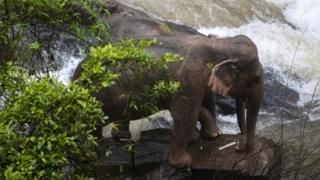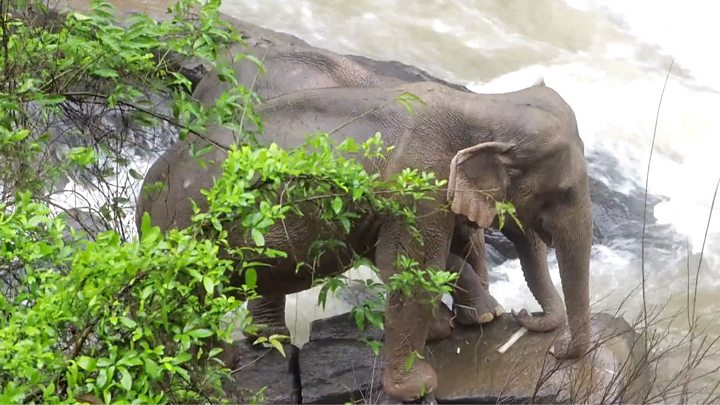Thai elephant deaths: Do elephants risk their lives to save each other?
A tragedy in Thailand has pulled on our heartstrings, and can help us learn about elephant empathy. …

 Image copyright AFP
Image copyright AFP Last week, Thailand suffered one of its biggest ever single elephant tragedies, when 11 animals in one family died in a swollen river.
At first only six elephants were thought to have died – days later another five were spotted downstream.
The initial theory from park rangers in Khao Yai National Park was that they died in a rescue mission. As they crossed the treacherous 150m-tall Haew Narok – or Hell’s Falls – a baby slipped and the others fell trying to save it.
Though the loss of 11 elephants isn’t catastrophic to the species, there is something about them that draws us in, and this apparent self-sacrifice struck a chord around the world – millions of you read our story alone.
But emotions aside, how plausible is it that elephants would have both the empathy and skill to risk their lives for a baby? And perhaps more importantly now, what does this mean for the survivors?
Dr Joshua Plotnik, assistant professor of psychology at Hunter College City University of New York, has been studying elephants in Thailand for more than a decade.
He told the BBC that with no witnesses, we can’t assume what happened. But he says it’s “certainly reasonable to suspect that when an elephant in a family group is in danger the other elephants might do everything they can to go help”.
There is well documented evidence of elephants recognising danger and co-ordinating their actions to stage a rescue.
But Dr Plotnik says it seems unlikely that they would “actively all go over a waterfall in a dangerous situation like that”.
It was more likely a terrible accident.
Dr Rachel Dale, an elephant behaviour specialist at the University of Veterinary Medicine in Vienna, agrees that elephants will unquestionably help an elephant in danger, “even if it’s at a cost to themselves”.
But they’re also “smart animals, really smart”, she says, so probably have the ability to carry out a kind of perfunctory risk assessment before rushing in.
Notoriously dangerous
Bhichet Noonto leads the Thailand Human-Elephant Coexistence Project at the office of Thailand Science Research and Innovation, studying patterns of elephant behaviour.
He said conditions in the park were miserable at the time of the accident, and Haew Narok was already a known hazard to elephants in the monsoon season.
In 1992, eight elephants died after tumbling over the same falls – park officials have said they witnessed a mother on that occasion jump in after a baby. A calf is also suspected of having fallen off a cliff there in 1987.
To prevent further accidents, park officials constructed miles of concrete pillars to steer them away from hazardous places.
But they couldn’t cover everywhere, and the rangers have seen footsteps indicating this group had followed one fence all the way up the falls until they found a way through, right at the top.
You might also be interested in:
The Department of National Parks, Wildlife, and Plant Conservation (DNP) said the elephants may have been looking for a particular local plant, which only grows in that area once a year, and they may have taken a risk to reach it. Alternatively, they may have gone out of their way to avoid interacting with humans.
“There are many types of elephants: polite, naughty, and nice just like humans. When some of them walk outside of the routes that they are used to, they have a high risk of falling,” said DNP director Songtham Suksawang.
‘Trauma’ of survivors
In another emotional twist, two elephants are known to have survived the fall – a mother and calf. They were trapped by the slippery rocks at the bottom, but with the help of park officials made it to safety.

Media playback is unsupported on your device
If elephants do indeed have the empathy and intelligence to understand when one of their kind is in danger and try to save them, what does that mean for these survivors?
“This is a large-brained, intelligent, social, empathetic animal,” says Dr Plotnik. “I would argue they would suffer the same kind of trauma we would suffer.”
The exact relationship between the family members is not yet known, but if their matriarchal leader was among the dead, they’ll have lost decades of vital knowledge about their jungle home.
Because elephant lives are about as long as ours and they rely on generational knowledge, Dr Dale explains, it could take a very long time to see the effect of this kind of loss and whether it changes their behaviour or traditional routes.
But park officials are confident the pair have the skills to survive and will learn from their experience to avoid the falls.
Mr Noonto says reports from the area suggest there may be more family members elsewhere that the two survivors can reunite with. Failing that, they may be taken in by another family group – studies of captive elephants being returned to the wild have shown this is possible, he says.
“They can survive, they can adapt,” he says. “Perhaps they will even encounter males to rebuild the family.”
‘The wild is not friendly’
There is undeniably an allure about elephants, an animal humans have built a relationship with over millennia. Despite their vast size, they are mostly gentle, live in families like us, appear to have fun, and we can watch them apparently mourn. It’s easy for us to empathise after a disaster like Khao Yai.
Dr Dale argues that anthropomorphism doesn’t ultimately help the elephants, though.
“Humans are good at certain things that help us survive,” she says. “What helps us survive doesn’t always help other animals to survive. So seeing things always through the human lens doesn’t help us to understand other species and what other animals need to thrive.”
By setting emotion aside and dispassionately assessing what makes them think and act the way they do, scientists can better determine how to prevent disasters like this.
Cases like this might be rare, says Dr Plotnik, but they are a reminder that even for an animal as huge as the elephant, “the wild is not a friendly place”.
The bodies of this group will be recovered and examined, then buried at the park. They will be remembered every year, in the park’s memorial services for its beloved lost elephants.
“It’s very sad for [park officials] because they didn’t want this to happen again,” says Mr Noonto. “This is very emotional for Thai people.”




